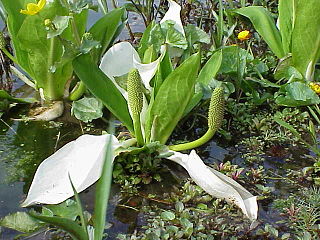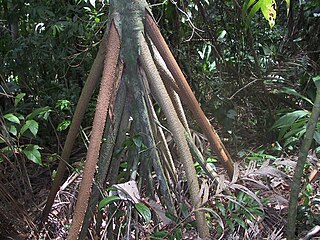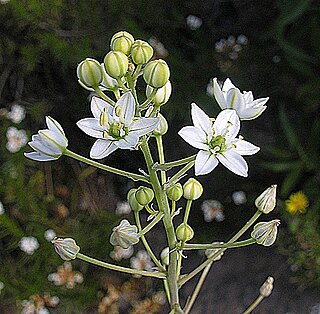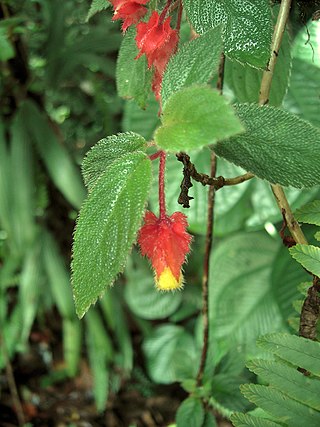
Erythronium, the fawn lily, trout lily, dog's-tooth violet or adder's tongue, is a genus of Eurasian and North American plants in the lily family, most closely related to tulips. The name Erythronium derives from Ancient Greek ἐρυθρός (eruthrós) "red" in Greek, referring to the red flowers of E. dens-canis. Of all the established species, most live in North America; only six species are found in Europe and Asia.

Dactylorhiza maculata subsp. fuchsii, the common spotted orchid, is a subspecies of flowering plant in the orchid family Orchidaceae.

A daylily, day lily or ditch-lily is a flowering plant in the genus Hemerocallis, a member of the family Asphodelaceae, subfamily Hemerocallidoideae, native to Asia. Despite the common name, it is not taxonomically classified in the lily genus. Gardening enthusiasts and horticulturists have long bred Hemerocallis species for their attractive flowers; a select few species of the genus have edible petals, while some are extremely toxic. Thousands of cultivars have been registered by the American Daylily Society, the only internationally recognized registrant according to the International Code of Nomenclature for Cultivated Plants. The plants are perennial, bulbous plants, whose common name alludes to its flowers, which typically last about a day.

Gloriosa is a genus of 12 species in the plant family Colchicaceae, and includes the formerly recognised genus Littonia. They are native in tropical and southern Africa to Asia, and naturalised in Australia and the Pacific as well as being widely cultivated. The most common English names are flame lily, fire lily, gloriosa lily, glory lily, superb lily, climbing lily, and creeping lily.

Oncidium, abbreviated as Onc. in the horticultural trade, is a genus that, as of December 2023, contains about 340 species of orchids from the subtribe Oncidiinae of the orchid family Orchidaceae. It is distributed across tropical and subtropical America from Mexico, Central America and the West Indies to northern Argentina, with one species (O. ensatum) extending into Florida. Common names for plants in this genus include dancing-lady orchid and golden shower orchid.

Lysichiton is a genus in the family Araceae. These plants are known commonly as skunk cabbage or less often as swamp lantern. The spelling Lysichitum is also found. The genus has two species, one found in north-east Asia, the other in north-west America.

Drakaea is a genus of 10 species in the plant family Orchidaceae commonly known as hammer orchids. All ten species occur only in the south-west of Western Australia. Hammer orchids are characterised by an insectoid labellum that is attached to a narrow, hinged stem, which holds it aloft. The stem can hinge only backwards, where the broadly winged column carries the pollen and stigma. Each species of hammer orchid is pollinated by a specific species of thynnid wasp. Thynnid wasps are unusual in that the female is flightless and mating occurs when the male carries a female away to a source of food. The labellum of the orchid resembles a female thynnid wasp in shape, colour and scent. Insect pollination involving sexual attraction is common in orchids but the interaction between the male thynnid wasp and the hammer orchid is unique in that it involves the insect trying to fly away with a part of the flower.

Copernicia is a genus of palms native to South America and the Greater Antilles. Of the known species and nothospecies (hybrids), 22 of the 27 are endemic to Cuba. They are fan palms, with the leaves with a bare petiole terminating in a rounded fan of numerous leaflets. The species are small to medium-sized trees growing to 5–30 m tall, typically occurring close to streams and rivers in savanna habitats. The genus is named after the astronomer Nicolaus Copernicus. In some of the species, the leaves are coated with a thin layer of wax, known as carnauba wax.

Socratea is a genus of five species of palms found in tropical Central America and South America.

Tradescantia ohiensis, commonly known as bluejacket or Ohio spiderwort, is an herbaceous plant species in the genus Tradescantia native to eastern and central North America. It is the most common and widely distributed species of Tradescantia in the United States, where it can be found from Maine in the northeast, west to Minnesota, and south to Texas and Florida. It also has a very small distribution in Canada in extreme southern Ontario near Windsor.

Guzmania monostachia is an epiphytic species in the genus Guzmania. Also known as a West Indian tufted airplant, this species is native to South America, Central America, the West Indies and Florida. The species is also reportedly naturalized in Hawaii.

Guzmania angustifolia is a species of flowering plant in the Bromeliaceae family. It is native to Costa Rica, Nicaragua, Panama, Colombia, and Ecuador.
Guzmania brasiliensis is a plant species in the genus Guzmania. This species is native to northern Brazil, Peru, Colombia, Venezuela and Ecuador.
Guzmania graminifolia is a species of flowering plant in the Bromeliaceae family. It is native to Ecuador, Peru, Colombia and Panama.
Guzmania melinonis is a species of plant in the genus Guzmania. This species is native to Bolivia, Peru, Colombia, the Guianas, Venezuela, Amazonas State of Brazil, and Ecuador.

Guzmania musaica is a plant species in the genus Guzmania. This species is native to Costa Rica, Panama, Ecuador, Venezuela and Colombia.
Guzmania pearcei is a species of flowering plant in Bromeliaceae family. It is native to Ecuador and Colombia.

The World Checklist of Selected Plant Families was an "international collaborative programme that provides the latest peer reviewed and published opinions on the accepted scientific names and synonyms of selected plant families." Maintained by the Royal Botanic Gardens, Kew, it was available online, allowing searches for the names of families, genera and species, as well as the ability to create checklists.

Oziroe is a genus of bulbous South American plants in the squill subfamily within the asparagus family. Within the Scilloideae, it is the sole member of the tribe Oziroëeae and the only genus in the subfamily to be found in the New World.

Crantzia is a plant genus in the family Gesneriaceae. Crantzia species grow in damp or wet forests, mostly on Caribbean islands. Some are epiphytes, others are subshrubs or herbaceous plants with fibrous roots.
















